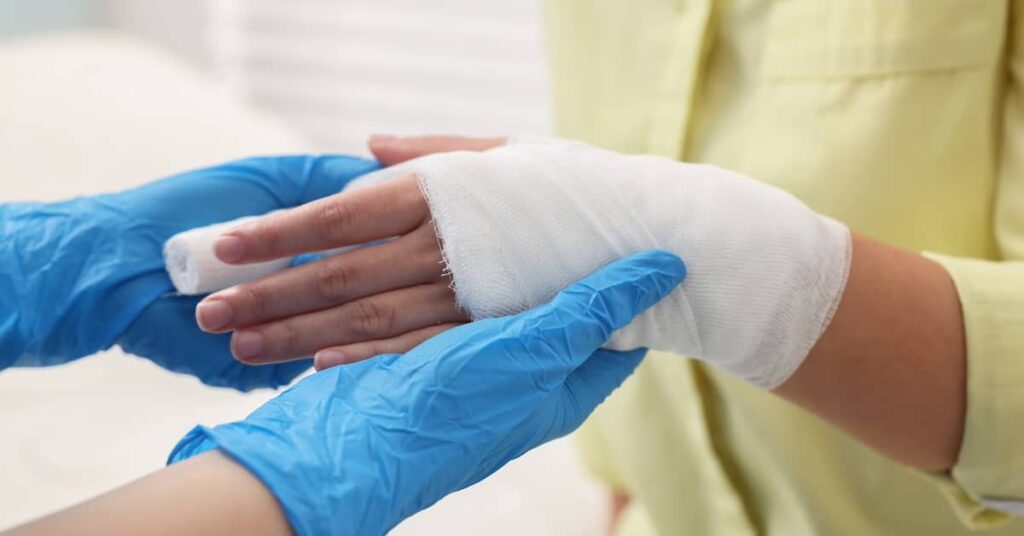
How Much Compensation for a Burn Injury?
You may be entitled to burn injury compensation if your burns were caused by the negligence of another. A Denver burn injury lawyer can investigate to determine who is responsible and calculate the value of your claim.
Burn injuries are serious. They are painful, disfiguring, and they can significantly alter both physical capabilities and quality of life. Burn injury attorneys at Burg Simpson can explore your right to compensation and fight to hold the defendant(s) accountable.
Call Burg Simpson at 303-792-5595 today for a FREE and confidential case evaluation. Our firm handles burn injury compensation claims for clients in Denver, Englewood, and throughout Colorado.
What Is the Average Burn Injury Claim Worth?
It is important to note that there is no such thing as an “average” burn injury claim. Every case is different, and you cannot rely on other legal outcomes to understand what your claim may be worth.
A Denver burn injury lawyer will evaluate multiple factors to determine the compensation you may be due. These include:
The Degree of the Burn Injury
The severity of a burn injury is classified by degree. Degrees represent the depth of the injury to the skin.
Medical professionals categorize burns as follows:
- First-degree burns: These are the least severe type of burn, affecting only the outermost layer of the skin (the epidermis). With first-degree burns, the skin is red, dry, and painful to the touch. Peeling begins within several days as the burn starts to heal.
- Second-degree burns: A second-degree burn affects both the epidermis and the inner layer of the skin (the dermis), resulting in significant pain and discomfort. The skin may be red or brown in color, as well as appear moist or shiny. Swelling and blistering of the burned area are common.
- Third-degree burns: A third-degree burn damages all the layers of skin—the epidermis, dermis, and hypodermis (subcutaneous tissue). This is a serious injury requiring immediate medical attention. With a third-degree burn, the skin may be charred or leathery in appearance with white or black coloring. Despite the severity of the damage, third-degree burns may cause minimal pain due to the destruction of nerves.
- Fourth-degree burns: The most serious type of burn injury, fourth-degree burns extend beneath the layers of skin and damage soft tissue and bone. Depending on the size and location, fourth-degree burns may be life-threatening.
The Area Affected by the Burn
Another key consideration in assessing the seriousness of a burn injury is the percentage of body surface area damaged by burns. Medical providers often use the “Rule of Nines” to estimate the size of a burn.
This method assigns a percentage value to different areas of the body (the head, torso, arms, legs, and groin). When the percentages are added up, the total represents the estimated portion of skin affected by burns. Burns are considered major if they cover 15–20% of the body for adults and 10% of the body for children.
Burns on certain areas of the body are automatically considered serious. These include:
- Face and neck
- Hands
- Feet
- A burn covering any joint
- Genitalia and buttocks
- Burns fully encircling any area of the body (such as the chest and upper back, abdomen and lower back, all the way around an arm or leg, etc.)
Medical Treatment Requirements
Minor burns may be treated with first aid, while serious burn injuries will likely require treatment in the emergency room and hospital. In extreme cases, the victim may need to be transferred to a burn center for specialized care.
Treatments that may be needed for a severe burn include:
- IV fluid management to maintain blood pressure, prevent dehydration, and reduce the risk of shock
- Wound care, such as cleaning and dressing the burn injury site and removal of damaged tissue (debridement)
- Additional infection control measures, such as antibiotic medications, application of topical antimicrobials, and isolation in a sterile environment
- Surgical procedures such as:
- Escharotomy to restore blood flow and relieve pressure from dead tissue (eschar) that forms around a circumferential burn injury
- Fasciotomy to reduce swelling in the fascia surrounding the muscle; this is key for preventing a serious complication known as compartment syndrome
- Skin grafts using autologous tissue (i.e., tissue from the patient) or synthetic materials to replace tissue destroyed by the burn
- Pain management
- Rehabilitation and therapy, including:
- Physical therapy to regain mobility and function
- Occupational therapy to regain the ability to perform daily tasks
- Vocational therapy to return to work or identify other avenues for employment
- Psychological counseling and support to manage depression, anxiety, and other issues
Medical expenses represent a significant portion of burn injury compensation and losses in other catastrophic injury claims. Both the cost of medical treatment to date, as well as expenses for care in the future, must be accurately accounted for when assessing the potential value of a burn injury claim.
Length of Recovery
Recovery from a burn injury can be a lengthy and challenging process. The recovery time for third-degree burns of a significant size is generally measured in years. Severe third- and fourth-degree burns may lead to permanent impairment and limitations.
A burn injury claim should take into account how long the recovery takes and the challenges the victim faces during that time. This includes physical pain, psychological distress, inability to earn a living, and more.
Impact on the Victim’s Life
The more severe and far-reaching the effects of a burn injury, the more compensation the victim is likely to recover. Claims involving permanent disability, extensive scarring, profound disfigurement, and major impacts on lifestyle and/or relationships with family members tend to be worth more than claims centering on less-serious injuries.
How Much Compensation Do You Get for a Burn?
As you can see, there is no set number or hard-and-fast rule for calculating the burn injury compensation available following an accident. If you suffered burns due to the negligence of another party, it is in your best interest to consult a knowledgeable personal injury attorney as soon as possible.
Damages that may be recovered for burns include:
- Current and future medical expenses
- Loss of income and earning capacity
- The cost of household support and services
- Home and vehicle modification expenses
- Pain and suffering
- Emotional anguish
- Impairment of quality of life
Colorado places no cap on economic damages, so quantifying all costs and financial losses is critical. Starting January 1, 2025, non-economic damages in Colorado (such as pain, suffering, etc.) are capped at $1.5 million. As a rule, punitive damages may not exceed the total value of economic and non-economic damages (see Colorado Revised Statutes § 13-21-102).
How a Denver Burn Injury Lawyer Can Help
The complex nature of burn injuries can make it difficult to measure the quantifiable and intangible effects. An experienced burn injury attorney can collect evidence, consult experts, and prepare a strong claim on your behalf.
In addition to accurately calculating the value of your claim, enlisting legal counsel is key for maximizing your burn injury compensation. Your lawyer will negotiate with the insurance company on your behalf with the goal of reaching a fair settlement.
If a fair settlement cannot be reached, you need to know that your attorney is willing to file a lawsuit and, if necessary, take the case to trial. Seasoned trial lawyers will not hesitate to prepare your case for trial and fight for a favorable judgment from the court on your behalf.
Pursuing the Burn Injury Compensation You Deserve
Burg Simpson has extensive experience representing burn victims. We understand the devastating toll serious burns can take, and we aggressively explore all avenues for obtaining maximum compensation.





